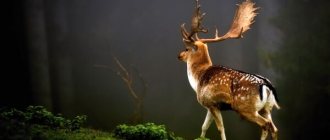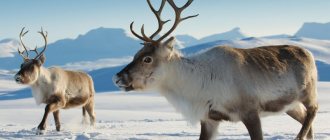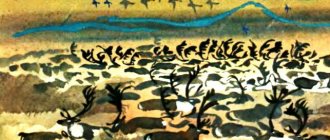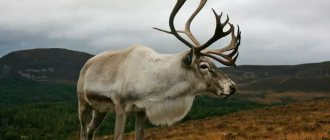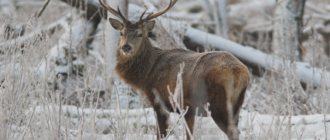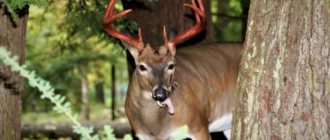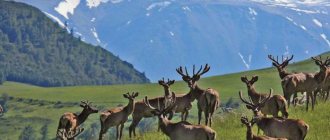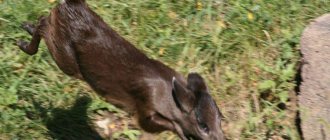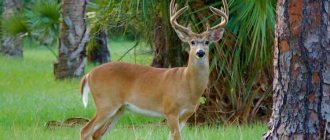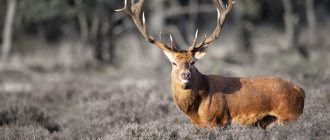Get ready to meet the most graceful member of the deer family. The deer is medium-sized with a rich reddish coat decorated with contrasting bright white patterns. White patterns cover the entire body of the animal except the head. The deer retains this color throughout the year. On the head there are large and branched horns with long processes. The shape of the horns resembles a harp. Deer are capable of shedding their antlers more than once a year. Axis's weight can reach 100 kilograms. A distinctive feature of the species is the dark stripe on the back.
Description of the sika deer
Sika deer is a slender animal with a light build (body length for males reaches 2 m, weight about 130 kg, females are always more modest in size).
Only males have horns with four tips. The length of the horns reaches 80 cm, their weight is about 1.3 kg. Males shed their antlers in April; in June, young horns with two or three shoots appear. The summer coat of a sika deer has a characteristic spotted color, white spots are located on a reddish-red general background, while in winter the deer becomes monochromatic, dark gray. The animal has a long thick mane on its neck and a large white spot around its tail, making it easy for the animals to see each other even in the densest thickets. At night, sika deer find each other by the shine of their eyes, which in the dark acquire a dark orange glow. — Advertising —
The body length of the sika deer is from 160 to 180 cm, the height is 95-112 cm, and the body weight ranges from 75 to 130 kg. This species differs from European fallow deer in that it does not have spade-shaped thickenings on the antlers and the shape of the spots on the body is different.
Feeding characteristics of the sika deer
Sika deer belongs to the group of herbivores.
Its diet includes a wide variety of vegetation, as well as nuts, legumes, acorns, lichens, berries, seeds, and chestnuts. In winter, sika deer are completely unpretentious in food, and are content with everything that they manage to get from under the snow, for example, withered leaves, pine needles and tree bark. In order to provide themselves with a sufficient amount of minerals, sika deer willingly lick salt and gnaw soil rich in salts. The colder it is, the more food this animal needs, so rangers try to place additional food in the forests.
Nutrition
The diet of deer consists of various herbs, as well as forest flowers and fruits. To obtain the required supply of proteins, Axis eat mushrooms. Throughout the year, animal nutrition is determined by climatic conditions. During the cold period from October to January, the deer's diet includes shrubs and tree leaves. The process of obtaining food among the Axis is collective in nature. Deer gather in packs and move quietly in search of food.
Distribution of sika deer
Red sika deer are known as taiga animals, as they prefer to hide among the dense thickets of deciduous and subtropical forests.
But each subspecies chooses for itself some separate living conditions. — Advertising —
For example, in the Sayan Mountains live deer, which are found in the upper parts of forests, gradually turning into alpine meadows. Red deer prefer oak forests located on the plains, and Bukhara deer are regulars in poplar thickets and dense bushes that are located on river banks.
Sika deer, which live in the mountains, prefer northern slopes in the summer and move to the southern slopes in winter. In the Far East, sika deer are common near the seashores, where you can feast on seaweed and salt.
Types of deer
Now on Earth you can count more than 50 species of animals belonging to the deer or deer family, which is part of the order of artiodactyls of the class of mammals. They are distributed everywhere.
Moreover, they were brought to the Australian mainland and the islands of New Zealand by people. Their size range is presented quite widely - from the size of a medium-sized dog to the serious dimensions of a large horse. Let us immediately make a reservation that all antlers in the deer family adorn only the heads of males, with the exception of a single genus.
The cervids include three subfamilies - water deer (Hydropotinae), Old World deer (Cervinae) and New World deer (Capreolinae). The last two names denote their place of historical origin rather than their current residence.
There are a large number of different species of deer
Old World Deer
This group united 10 genera and 32 varieties. Let's look at the most popular of them. Real (true) deer are divided into 2 types - noble and spotted.
1. The red deer inhabited almost the entire European territory; it can be seen in the countries of Asia Minor, in the Caucasus Mountains region, in Iran and in some places in the center and west of Asia. Many countries can be proud of his royal presence.
The handsome deer was even spotted in the territory from Tunisia to Morocco (near the Atlas Mountains), which makes it possible to call it the only deer that settled in Africa. This deer came to other continents of the Earth with the assistance of man.
It can be considered not as an isolated species of red deer , but as a collection of several varieties. Some diligent researchers count them up to 28. All red deer:
- Caucasian deer,
- wapiti (East Asian inhabitant of the taiga),
- maral (Siberian specimen),
- Crimean (inhabitant of Europe from the Baltic coast to the Balkan Peninsula),
- Bukhara (who chose Kazakhstan and Central Asia) and
- european deer,
- wapiti (North American representative)
They all have some differences - in size, weight, skin color, shape and size of horns. For example, deer and wapiti weigh more than 3 centners and are up to 2.5 m long. Their height is about 1.3-1.5 m at the withers. And the Bukhara deer is 1.7-1.9 m long and weighs three times less, about 100 kg.
The European deer has antlers in the form of a branched crown, which is its calling card. The deer does not have such a beautiful “tree” on its head; its horns consist of 7 branches, but they are massive.
Despite the external differences between the varieties, they all have common characteristics: they are not spotted in summer and have a white spot in the tail area, so impressive that it would be more correct to say that their entire loin is white.
Mostly light coffee, ash and brownish-yellow body colors are found. Their food is quite varied. The basic components are grass, tree bark and leaves. In the spring, they restore strength with protein foods - nuts, acorns, seeds, cereals, beans. In summer, berries, fruits, mosses, and mushrooms are added to the menu.
When there is a lack of salt, they find soil saturated with mineral salts, lick and chew it. They live in small groups, led by the female. Single and old males stay separately. The deer is a fast and graceful creature. He jokingly overcomes obstacles, making huge jumps, and easily swims across rivers.
However, his character cannot be called noble. Rather irritable, selfish, even with domesticated individuals you need to be on your guard. At the moment of irritation and rutting, it makes “trumpet” sounds.
During the rutting period, fights between males and females for territory are not uncommon.
The female produces 1-2 calves, they mature by 2-3 years, acquiring their first horns at the age of 7 months. Healing properties have always been attributed to different parts of the deer’s body. For example, young deer antlers (antlers) are most valued in Eastern medicine as a source of medicine for longevity.
It remains to be seen why this creature was called noble. The answer is easy to see in old paintings. Painters often depicted a majestic animal with its head thrown back proudly, magnificent horns, it stood, spreading its hooves on the ground - all this looks like a portrait of the “king of the forest”.
Antlers are the soft antlers of deer.
2. Sika deer. The dimensions are inferior to its previous brother, the body is about 1.6-1.8 m long, at the withers height is 0.9-1.1 m, weight is from 70 to 135 kg. However, the main difference with its noble relative is the color.
In summer, it acquires a bright red color with a reddish tint, on which snow-white spots stand out noticeably; in winter, the whole palette turns pale. Occupies Southeast Asia, settled in Japan and northern Primorye. In the first half of the 20th century, it was brought to central Russia and the Caucasus.
The rut occurs in the fall, peaking in October, like the red deer. At that moment, clashes between competing males are common, however, all deer are distinguished by this. However, they rarely suffer fatal injuries in such a skirmish. They may get caught in their horns and not free themselves from each other, and then they die of hunger.
Sometimes among the males of all varieties there are hornless individuals. Then they are not destined to take part in mating fights and receive the female’s attention as a reward; their destiny is to penetrate someone else’s seraglio (the female territory of the herd) unnoticed. Real deer live up to 20 years.
- Previously, the white-faced deer , which chose the Tibetan Plateau to live, was also classified as a true deer. However, now it is separated into its own clan. It gets its name from the front of its head, which is painted white. It lives in coniferous forests, as well as in alpine meadows at an altitude of 3.5 to 5.4 km in the mountains.
- In Southeast Asia there lives a rather rare species of deer - the lyre deer . It got its name from the unusual shape of its horns. Now there are three subspecies - Manipuri (resident of a national park in the Indian state of Manipur), Thamin (Thailand, eastern India and Burma) and Siamese (southeast Asia). Currently, all 3 subspecies are listed in the International Red Book.
Lyra is considered one of the rarest deer
- There are several exotic deer that can be seen in India. For example, the Barasinga deer . If we nominate types of deer antlers , then the outstanding decorations of this creature will be one of the first.
They cannot compete in size with other deer, but they have a large number of shoots. Actually, the word “barasinga” is a deer with 12 antlers. Although, in fact, there can be up to 20 shoots.
- Old World deer include several species of sambar . These are deer that prefer a mainly nocturnal lifestyle and live in southeast Asia and nearby islands. There are four known: the Philippine, the maned (named for its long, stiff, dark-colored hair), the Indian and their close relative, the Philippine sika deer.
The latter belongs to the endangered representatives, although its presence greatly embellishes the category of sika deer species .
In the photo there is a sambar deer
- Here it is appropriate to recall two more owners of beautiful spotted skins - the spotted Buria or Axis (a resident of the Himalayas, Ceylon and Armenia) with reddish-golden fur covered with snow-white speckles, and the fallow deer (a medium-sized European deer with wide antlers).
The color of the fallow's upper body in summer is especially bright, red-fiery with speckles the color of milk. The lower body is a soft beige color, the legs are light.
In the photo there is an axis deer
The fallow deer is easy to recognize by its “shouldered” antlers
- In the south and southeast of Asia, muntjacs - small deer with a very simple structure of horns - one, rarely two branches measuring no more than 15 cm. Their fur is mostly gray-brown or yellow-brown, sometimes with large light ones. in sections.
Males have sharp incisors in the upper part, with which they are able to bite not only the stem, but also the branch. It remains to add that the tail of these deer is quite long - up to 24 cm.
- An interesting representative of the Old World deer is the tufted deer . It, like muntjacs, has a fairly long tail, sharp fangs, and a body size of no more than 1.6 m in length. Weight can be no more than 50 kg.
In addition, like its previous relatives, it is active during the twilight hours - morning and evening. On the head there is a black-brown crest up to 17 cm high. The horns are short, without branches, often not visible because of the crest. Lives in southern China.
New World deer
1. American deer are one of the most famous representatives of this subfamily. They live only in North America. Body color ranges from dark red to light yellow. They are represented by two species - white-tailed and black-tailed deer.
The first lives mainly in the state of Virginia, hence the second name - Virginian. The second one has long ears, which is why it is called “donkey”. Their birth rate is higher than other species - they produce up to 4 cubs. Therefore, their numbers are quickly restored, despite the annual extermination during the hunting period.
2. Swamp deer and pampas deer are 2 monotypic genera that live in South America. The first prefers swampy lowlands and river banks. It feeds mainly on aquatic plants, such as reeds and water lilies. The fur is grey-brown. The second one loves savannas with dry soil. The fur is red on the back and whitish on the belly.
Swamp deer prefer to feed on plants and grasses growing on swamp soils
3. Mazama are deer mammals that live in the forests of Central and South America. Their name comes from the Indian language Nuatl, and simply means “deer.” The horns are unbranched and consist of only two small processes.
Now there are about 10 species, ranging in size from 40 cm and weighing 10 kg (dwarf mazama) and up to 70 cm in height and weight 25 kg - gray mazama.
4. Pudu – southern and northern. Small animals from the deer family, measuring up to 40 cm at the withers and weighing up to 10 kg. They have short horns up to 10 cm. They live in Southern Chile.
Pudu deer is considered the smallest representative of the species
5. Andean deer - Peruvian and South Andean. Endemics of the Andes mountain system. Quite large deer with light brown fur and Y-shaped antlers. The body can be called quite dense compared to the legs. Active at dusk, hiding among rocks during the day. The Andean deer, along with the condor, is depicted on the coat of arms of Chile.
The remaining genera of deer are not included in any subfamily; they act as separate groups of their own.
Common subspecies of sika deer
There are about 15 subspecies of sika deer, which differ in size and habitat.
For example, wapiti and marals are very large deer, their body length sometimes reaches 2.5 meters, weight up to 300 kg, and Bukhara deer, on the contrary, are relatively small in size, their weight is up to 100 kg, and their body length ranges from 75 up to 90 cm. The shape of the horns also differs among the subspecies of sika deer. Thus, European deer have many branches, and deer have a massive branched horn without a crown.
Sika deer behavior
Wild spotted deer are secretive, shy, quiet and very cautious animals.
It is very difficult to meet representatives of this species in forests, since they can sense the approach of people and predators at long distances. The sika deer is helped in this by its well-developed hearing and sense of smell. In general, sika deer are not easy prey. He can run fast when being chased and swims well, so he can easily hide from predators pursuing him in the water. In such cases, the animal jumps into the water and quickly swims to the depths. On water, sika deer are capable of covering distances of several kilometers. In addition, this animal is capable of jumping 2.5 meters in height and up to 8 meters in length.
Sika deer lead a sedentary lifestyle in small groups, sometimes uniting in large herds. The home range of one herd is several square kilometers, which the deer mark and whose borders are protected from all strangers. Grazing occurs mainly at night, when the risk of attack by predators is not so great.
Habitat
In our country, this subspecies of deer is found in the Primorsky Territory. From the Far East it was transported to many other regions - the Urals, the Caucasus, Vladimir, Smolensk, Moscow region, Tver, Kaluga, Yaroslavl and others.
This species of artiodactyl also lives in other countries - China, Vietnam, Japan and the island of Taiwan. The animal was also imported to the USA and New Zealand, where it successfully took root.
Imported deer spread throughout Europe - England, Ireland, Scotland, France, Denmark, Austria, Germany, Poland, Switzerland.
Habitats
The optimal place for sika deer to live is deciduous forests. Other areas with dense vegetation are also suitable.
The Ussuri sika deer, living in the vast expanses of the Primorsky Territory, gravitates towards deciduous forests, among which it distinguishes oak ones. The animal can be found less frequently in mixed forests. Deer also prefer old clearings and burnt areas, where there is plenty of food in the form of low-growing bushes.
In winter, the animal lives on slopes on the southern and southeastern sides, where the snow quickly melts. Males climb slightly higher than females and calves, but do not rise further than five hundred meters.
In the Ural and Caucasus regions, deer occupy mixed and deciduous forests with densely growing young animals.
Reproduction of sika deer
The mating season for sika deer begins in the fall.
At this time, the males roar loudly, and from 2 to 20 females gather around them. Rival males can start fights for dominance. At the same time, they clash their horns so hard that the sound of these collisions can be heard hundreds of meters from the place of battle. Females give birth for the first time at the age of 2-3 years, the duration of pregnancy is 7.5 months. Usually one baby is born, who spends the first ten days of life lying in the grass. The mother grazes next to the cub and distracts predators from it. In the first months of life, the fawn is very weak and needs frequent feeding. Later he switches to plant foods, but milk feeding lasts up to 1 year.
The lifespan of a sika deer in the wild is 10-14 years. On the territory of nature reserves and on special farms for breeding this species, animals reach 20 years of age.
Mating season
This representative does not have a specific time for the start of the mating season. During estrus, the leader of the pack becomes very excitable and prepares to fight anyone who approaches his herd. During the breeding season, fights between males are common. Like most deer, Axis prove their superiority by fighting with the use of antlers. Conflicts between deer are accompanied by wild roars. The winner of the fight gets the right to mate with the female. As a rule, a female gives birth to at least 2 fawns. During the 7th week, the baby is fed with mother's milk. Quite often after giving birth, the female mates again. Thus, in a little more than a year, it produces two offspring.
Natural enemies of sika deer
Sika deer have a lot of natural enemies. Among the predators that attack them are wolf, leopard, tiger and bear. Young animals often become victims of Ussuri yellow martens (harza) and lynxes. In winter, when there is a lot of snow and in spring, sika deer become very weak due to poor nutrition and often become prey to predators.
Axis: natural enemies, population, species status
It must be said that the axis deer is very timid, for this reason it often manages to avoid mortal danger. Nevertheless, they have a huge variety of natural enemies. In dense forests, predators such as bears and wolves await them. They are often hunted by representatives of the cat family. It is interesting that the Indian relative of the deer is always close to the shelter so that there is an opportunity to escape in a timely manner.
This deer species has an extremely low chance of extinction according to the IUCN. Currently, the population of these animals is being monitored. Pastures with deer are quite common, and many naturalists take photos of the Axis deer for themselves. In fact, this still does not mean that these animals are not in danger at all, because humans are still the most terrible enemy for these cute creatures.
The article was read by 219
Interesting facts about the sika deer
- By the end of the first year of life, male sika deer develop bumps on their foreheads, which will then turn into powerful antlers. Unossified antlers of sika deer are a very valuable pharmaceutical product, which is why the animals were exterminated en masse at one time. The embryos, tail, blood, sinews, skin and meat of this animal species were also in demand, and as a result of such active hunting, by the beginning of the 20th century, the sika deer became a rare endangered species and was listed in the Red Book. The situation was corrected by opening special reindeer farms, which are now supplying raw materials for pharmaceutical needs. But, for example, the number of the Ussuri subspecies of sika deer could not be restored.
- Every year, before the start of spring, male sika deer shed their antlers. Their first antlers are very modest, but those that appear later before 10-12 years of age always contain many shoots and look very impressive.
